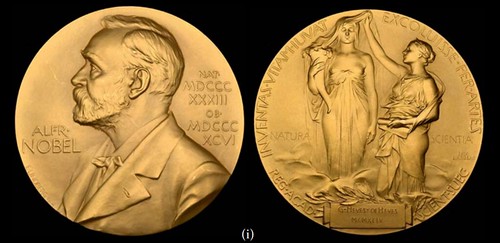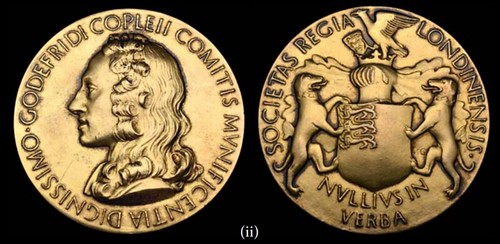
PREV ARTICLE
NEXT ARTICLE
FULL ISSUE
PREV FULL ISSUE
AWARD MEDALS OF GEORGE DE HEVESY OFFEREDThe Nobel Prize in Chemistry and other medals awarded to scientist George de Hevesy are offered in the November 23, 2017 sale by Morton & Eden. These are seldom-seen medals and
are pictured below. -Editor
 Hevesy Nobel Medal for Chemistry (i) Nobel Medal for Chemistry, in 23 carat gold, by Erik Lindberg, obv., bust of Alfred Nobel left, rev., INVENTAS VITAM IUVAT EXCOLUISSE PER ARTES, allegorical figures of Science holding scroll unveiling Nature holding cornucopia, REG. ACAD. SCIENT. SUEC. below, divided by panel engraved G. HEVESY DE HEVES MCMXLIV, edge marked GULD and dated 1944, 66mm, 207.75g  Hevesy Royal Society’s Copley Medal (ii) Royal Society’s Copley Medal, in silver-gilt, by Mary Gillick, awarded in 1949, edge engraved PROFESSOR GEORGE CHARLES de HEVESY. For. Mem. R.S., 56.8mm  Hevesy Royal College of Physicians’ Baly Medal, (iii) Royal College of Physicians’ Baly Medal, in silver, by J.S. and A.B. Wyon, edge engraved GEORGE DE HEVESY. 1951, 58mm Back in 2006 we related the famous story of how George de Hevesy managed to save the gold medals of two fellow Nobel winners in WWII. -Editor
[Unless you're a Nobel Laureate, I wouldn't recommend the storage procedures used at Niels Bohr's Institute of Theoretical Physics in Copenhagen during World War II. The Institute had been a refuge for German Jewish physicists since 1933. -Editor] "Max von Laue and James Franck had deposited their medals there to keep them from being confiscated by the German authorities. After the occupation of Denmark in April 1940, the medals were Bohr's first concern, according to the Hungarian chemist George de Hevesy (also of Jewish origin and a 1943 Nobel Laureate in Chemistry), who worked at the institute. In Hitler's Germany it was almost a capital offense to send gold out of the country. Since the names of the Laureates were engraved on the medals, their discovery by the invading forces would have had very serious consequences. To quote George de Hevesy (Adventures in Radioisotope Research, Vol. 1, p. 27, Pergamon, New York, 1962), who talks about von Laue's medal: "I suggested that we should bury the medal, but Bohr did not like this idea as the medal might be unearthed. I decided to dissolve it. While the invading forces marched in the streets of Copenhagen, I was busy dissolving Laue's and also James Franck's medals. After the war, the gold was recovered and the Nobel Foundation generously presented Laue and Frank with new Nobel medals." "de Hevesy wrote to von Laue after the war that the task of dissolving the medals had not been easy, as gold is "exceedingly unreactive and difficult to dissolve." The Nazis occupied Bohr's institute and searched it very carefully but they did not find anything. The medals quietly waited out the war in a solution of aqua regia." To read the earlier E-Sylum article, see: INTERESTING NOBEL PRIZE MEDAL LORE (http://www.coinbooks.org/esylum_v09n51a30.html) To read the complete sale catalog, see: Wayne Homren, Editor The Numismatic Bibliomania Society is a non-profit organization promoting numismatic literature. See our web site at coinbooks.org. To submit items for publication in The E-Sylum, write to the Editor at this address: whomren@gmail.com To subscribe go to: https://my.binhost.com/lists/listinfo/esylum All Rights Reserved. NBS Home Page Contact the NBS webmaster 
|